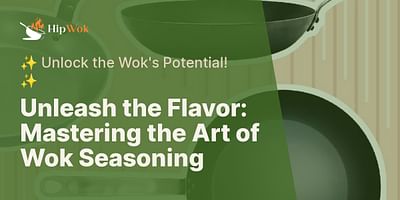Larry Pagac, a seasoned professional in the culinary scene, has dedicated over two decades of his life to mastering Asian cuisine. His profound expertise in the usage and versatility of the wok has been a pillar of his cooking style. Larry's enthusiasm for wok cooking has driven him to impart his wisdom and techniques through his articles.
Dear reader,
Seasoning your wok is an essential step to ensure its longevity and enhance its cooking performance. The process involves creating a natural non-stick surface on the wok, which not only prevents food from sticking but also imparts a unique flavor to your dishes. So, how long should you season your wok before using it? Let's dive in!
The duration of wok seasoning can vary depending on the type of wok you have and the method you choose. Generally, it is recommended to season your wok for at least 30 minutes to an hour. However, some wok enthusiasts prefer to season their woks overnight or even up to 24 hours for a more robust seasoning.
To get started, you'll need a few simple ingredients: cooking oil with a high smoke point (such as vegetable or peanut oil), a sponge or soft cloth, and a stovetop or oven.
Here's a step-by-step guide to seasoning your wok:
1. Wash your wok: Before seasoning, it's important to wash your wok with warm water and a mild dish soap to remove any factory coatings or residues. Use a sponge or soft cloth to gently scrub the surface. Avoid using abrasive cleaners or scouring pads as they can damage the wok's seasoning.
2. Dry thoroughly: After washing, make sure to dry your wok completely. You can either air-dry it or place it on low heat for a few minutes to evaporate any remaining moisture.
3. Heat the wok: Place your wok on the stovetop or in the oven and heat it over medium-high heat. Heating the wok will open up its pores, allowing the oil to penetrate and create a non-stick surface.
4. Apply oil: Once the wok is hot, add a generous amount of cooking oil to the surface. Use a heat-resistant brush or a folded paper towel to spread the oil evenly across the entire cooking surface, including the sides.
5. Heat and repeat: Continue heating the oiled wok over medium-high heat for about 10-15 minutes. During this time, you may notice the oil starting to smoke or even change color. This is a good sign that the seasoning process is taking place.
6. Cool down and wipe: After the initial heating, turn off the heat and allow the wok to cool down. Once it's safe to touch, use a sponge or soft cloth to wipe away any excess oil. This step helps to remove any impurities and ensures a smooth and even seasoning.
7. Repeat the process: To achieve a well-seasoned wok, it's recommended to repeat steps 3 to 6 at least two to three times. Each round of seasoning will further enhance the non-stick properties and develop a beautiful patina on the wok's surface.
Remember, seasoning a wok is not a one-time process. It's an ongoing maintenance routine that should be done periodically to maintain the wok's seasoning. After each use, clean your wok with warm water and a soft sponge, avoiding harsh detergents. Dry it thoroughly and apply a thin layer of oil to prevent rusting.
By following these steps, you'll be well on your way to seasoning your wok like a pro. So, grab your favorite ingredients, fire up your wok, and embark on a flavorful journey into the world of Asian cuisine!
Happy wok cooking!
Wok Master Wong















